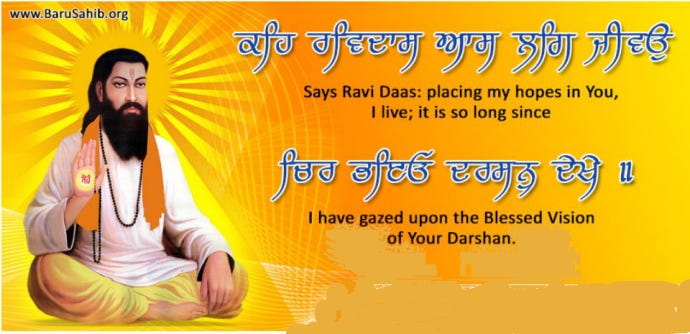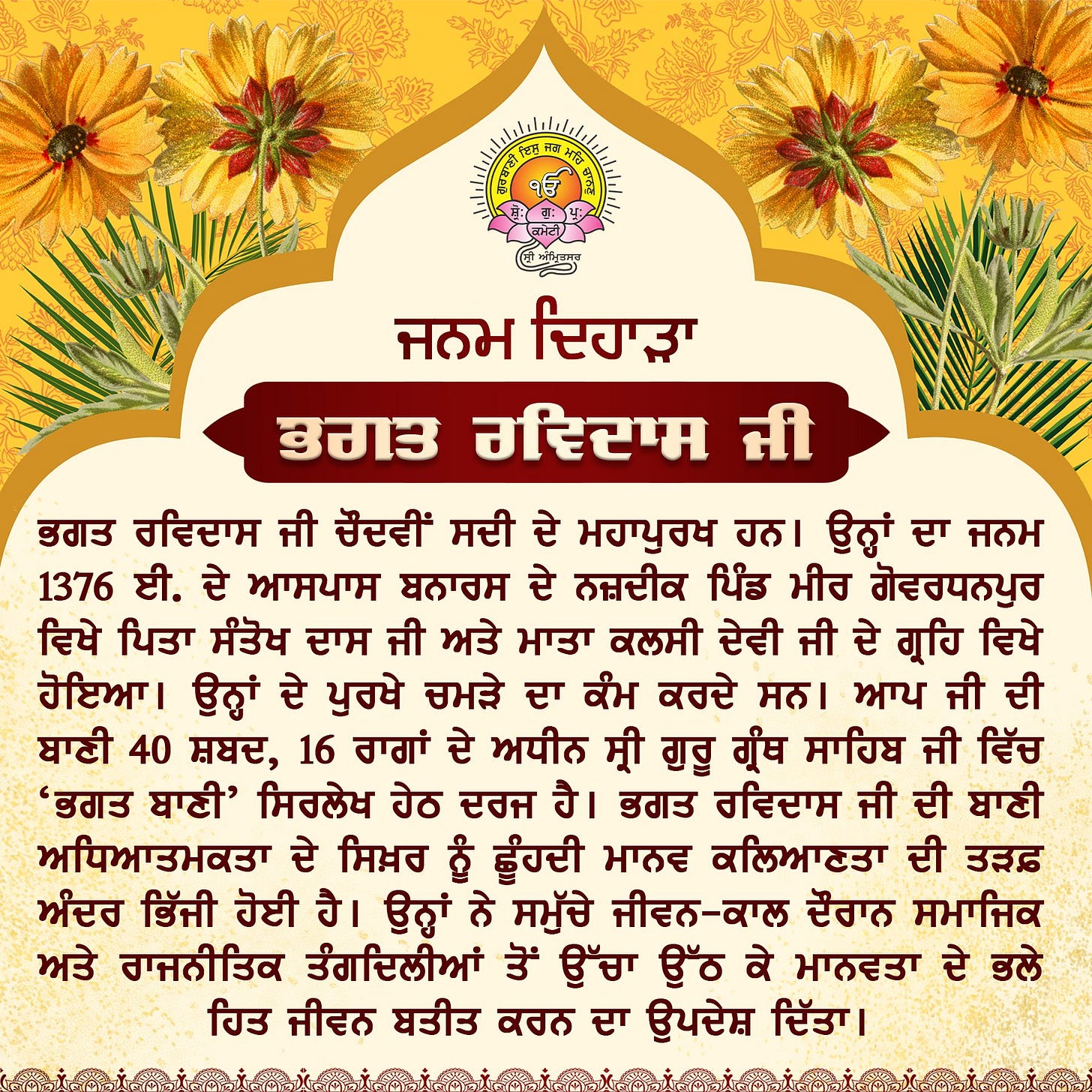Guru Ravidas: A Beacon of Equality and Spiritual Enlightenment
Our humble tribute on the auspicious occasion of his birth anniversary.
Guru Ravidas: Introduction
Bhagat Ravidas ji (Guru Ravidas for many), one of the most revered saints of the Bhakti movement, was a crusader against caste-based discrimination and a visionary who championed the ideals of universal equality, love, and devotion. His timeless teachings and soul-stirring hymns continue to resonate deeply among millions of Sikhs worldwide and devotees from diverse faiths, inspiring a commitment to spiritual liberation and social justice. His compositions, enshrined in the Sri Guru Granth Sahib (SGGS), embody a profound dedication to divine unity and an egalitarian society, rejecting social hierarchies and emphasizing the inherent dignity of all individuals. As we commemorate his 648th birth anniversary, it is imperative to reflect on his life, struggles, and enduring legacy, which remain as relevant today as ever, offering profound insights into the challenges of modern society and the pursuit of a just and inclusive world.
Early Life and Struggles Against Discrimination
Born in 1377 CE (1376 AD according to some sources) in the village of Seer Govardhanpur near Varanasi, Uttar Pradesh, Guru Ravidas belonged to the Chamar caste, traditionally engaged in leatherwork. From an early age, he experienced the rigid realities of the caste system, where "untouchables" were socially ostracized and subjected to deep discrimination. However, his extraordinary intellect, innate compassion, and unwavering devotion to God helped him rise above these limitations. Rather than accepting the social injustices imposed upon him, he actively challenged them. His teachings emphasized that a person’s true worth should be measured by their actions and character rather than their birth.
One of his most famous verses encapsulates this philosophy:
"Begampura shehar ko nao, dukh andohu nahi tihi thao..."
(There is a city called ‘Begampura’ where there is no pain, suffering, or discrimination, and all live as equals.)
His vision of "Begampura" was an early call for social justice, where all human beings would coexist in harmony, free from hierarchical divisions. This idea deeply influenced the Bhakti movement, which emphasized devotion to a formless God over ritualistic practices and caste distinctions.
Spiritual Journey and the Bhakti Movement
Guru Ravidas was a central figure in the Bhakti movement, which rejected caste-based hierarchies and emphasized devotion as the ultimate means to attain salvation. Unlike the priestly traditions that restricted access to spirituality, Ravidas preached that divine connection was accessible to all, regardless of caste or social standing. His devotional poetry, infused with deep mystical insights, became a vehicle for social reform.
Throughout his spiritual journey, Guru Ravidas attracted a vast following, including both commoners and the elite. Among his most devoted disciples was Queen Mirabai of Mewar, who considered him her Guru and deeply revered his teachings. His verses often emphasized unity with God, asserting that true devotion does not require birth in a particular caste but stems from a sincere heart and selfless service.
Significance of Khuralgarh Sahib
In 1515, Guru Ravidas visited Khuralgarh Sahib, located in the village of Kharali, Garhshanker, in Punjab’s Hoshiarpur district. He spent approximately four years, two months, and eleven days at this sacred site, spreading his message and uplifting marginalized communities.
According to legend, the local king, Van Singh, felt threatened by Guru Ravidas’ growing influence and attempted to undermine him. However, after witnessing Guru Ravidas’ spiritual strength and miracles, he became his disciple. One of the most famous miracles associated with Guru Ravidas in Khuralgarh Sahib was the emergence of a water source known as ‘Charan Ganga.’ It is believed that the saint moved a heavy stone with his toe, leading to the miraculous flow of water, which provided relief to the locals.
Recognizing the historical and spiritual significance of this site, the Punjab Government initiated the construction of the Shri Guru Ravidas Memorial at Khuralgarh Sahib. The foundation stone was laid in April 2016, and the memorial was dedicated to the public in February 2024. Built at an estimated cost of ₹143 crore, the memorial features several important facilities, including:
Minar-e-Begampura: A 151-foot-high tower symbolizing Guru Ravidas’ vision of an egalitarian society.
Sangat Hall: A congregation hall capable of accommodating up to 10,000 pilgrims.
State-of-the-Art Auditorium: Equipped with modern audio-visual aids to showcase the life and teachings of Guru Ravidas.
Multi-Level Parking and Tourist Facilities: To accommodate the influx of visitors.
This memorial is not only a tribute to Guru Ravidas but also an enduring symbol of his mission to eradicate caste-based discrimination and promote social harmony.
Guru Ravidas and Sikhism: A Lasting Connection
Since Guru Nanak Dev Ji was born in 1469, nearly a century after Guru Ravidas, there is no historical evidence of a direct meeting between them. However, Guru Ravidas' spiritual legacy found deep resonance within Sikhism, as his core teachings closely aligned with the principles later emphasized by Guru Nanak. Both the divine personalities advocated for devotion to one formless God (Nirgun Bhakti), the abolition of caste-based discrimination, and the equality of all human beings regardless of social or religious identity. Guru Ravidas' unwavering emphasis on inner purity over ritualism, truthful living, and selfless service mirrors the foundational tenets of Sikh philosophy, highlighting the spiritual synergy between the Bhakti and Sikh movements.
His spiritual compositions were later enshrined in the Sri Guru Granth Sahib, the holy scripture of Sikhism, which contains 40 of his hymns across 16 different Ragas. This inclusion is a testament to the respect the Sikh Gurus, especially Sri Guru Arjan Dev ji, had for his wisdom and philosophy, and his teachings continue to inspire millions within the Sikh Panth, particularly among the Ravidassia community.
Guru Ravidas’ Vision of Oneness in Sri Guru Granth Sahib
Guru Ravidas' profound spiritual wisdom is enshrined in the Guru Granth Sahib (SGGS), where 41 of his hymns are included across 16 different Ragas. One of his most celebrated compositions, found on Ang 93 of SGGS, begins with the evocative lines:
"Tohi mohi mohi tohi antar kaisa, kanak katik jal tarang jaisa"
(ਤੋਹੀ ਮੋਹੀ ਮੋਹੀ ਤੋਹੀ ਅੰਤਰੁ ਕੈਸਾ ॥ ਕਨਕ ਕਟਿਕ ਜਲ ਤਰੰਗ ਜੈਸਾ ॥)
(What is the difference between You and me? The difference is like that between gold and its ornaments, or water and its waves.)
In these verses, Guru Ravidas masterfully explores the relationship between the human soul (Atman) and the Divine (Parmatman), questioning the illusion of separateness. By employing the metaphors of gold and its jewelry, and water and its waves, he illustrates that just as ornaments remain gold in essence and waves remain inseparable from water, so too does the human soul remain inherently divine. The difference lies not in substance but in perception.
Through this composition, Guru Ravidas articulates a vision of non-duality (Advaita), wherein the soul and the Supreme Being are one and the same—differing only in manifestation but not in essence. His profound insight into the unity of creation, conveyed in simple yet deeply evocative language, aligns seamlessly with the Sikh concept of Ik Onkar—the indivisible oneness of the Creator and creation. By dissolving the illusion of duality, his teachings inspire seekers to recognize their divine nature and embrace a life of spiritual realization.
Sacred Shrine at Varanasi
Beyond Punjab, Guru Ravidas’ birthplace in Varanasi also holds great significance. The Shri Guru Ravidas Janam Asthan Mandir in Seer Govardhanpur is the focal point of devotion for millions of followers, admirers and devotees. Every year, Guru Ravidas Jayanti is celebrated here with immense fervor, drawing devotees from across India and beyond. The temple serves as both a religious and social center, symbolizing the resilience and determination of those who continue to fight against caste-based discrimination.
Legacy and Contemporary Relevance
Despite Guru Ravidas’ teachings of equality, caste-based discrimination continues to persist in India, even within communities that revere him. Though Sikhism fundamentally rejects caste distinctions, social realities sometimes tell a different story, with separate gurdwaras and social divisions still existing in certain areas. Recognizing this contradiction, many contemporary voices are advocating for greater inclusivity within religious and social institutions to honor the true essence of Bhakti and Sikh traditions.
The establishment of memorials like the Shri Guru Ravidas Memorial at Khuralgarh Sahib and the preservation of his sacred sites, such as the Guru Ravidas Janam Asthan Mandir in Varanasi, are crucial steps toward keeping his legacy alive. However, real change must go beyond monuments—it must be reflected in social attitudes, religious practices, and policies that truly uphold his teachings of equality and justice.
Summing Up: The Immortal Legacy of Guru Ravidas
Guru Ravidas’ vision of an egalitarian society remains a guiding light for those striving for justice and social harmony. His teachings challenged religious orthodoxy, social hierarchies, and caste-based discrimination, offering a progressive vision of a world where all human beings are equal. His idea of Begampura, the city without pain or suffering, continues to inspire efforts for social reform today.
While many saints before Guru Nanak Dev Ji also preached about a casteless society, it was due to Guru Arjan Dev Ji’s decision to include Guru Ravidas’ priceless verses in the Adi Granth (now Sri Guru Granth Sahib) that his compositions gained immortal status. This act not only ensured that his message was preserved but also elevated his spiritual philosophy to a sacred level, giving it universal acceptance beyond his lifetime.
As we commemorate his 648th birth anniversary, it is an opportunity to reflect on his message and work towards its realization in contemporary society. The true tribute to Guru Ravidas would be to dismantle caste-based barriers, foster inclusivity, and ensure that his teachings of dignity, equality, and spiritual liberation become a lived reality for all. By embracing his philosophy, we move one step closer to building the Begampura he envisioned—a world where justice, love, and equality reign supreme.




ਭਗਤ ਰਵੀਦਾਸ ਜੀ ਦੀ ਬੇਸ਼ਕੀਮਤੀ ਬਾਣੀ ਨੂੰ ਪੰਚਮ ਗੁਰਦੇਵ ਨੇ ਗੁਰੂ ਸਾਹਿਬਾਨ ਦੀ ਗੁਰਬਾਣੀ ਦੇ ਬਰਾਬਰ ਦਾ ਦਰਜਾ ਦੇ ਕੇ ਸਨਮਾਨ ਵਧਾਇਆ ਹੈ। ਸ੍ਰੀ ਗੁਰੂ ਗ੍ਰੰਥ ਸਾਹਿਬ ਜੀ ਵਿੱਚ ਉਨ੍ਹਾਂ ਦੇ ਨਾਮ ਨਾਲ ਭਗਤ ਰਵੀਦਾਸ ਜੀ , ਬਾਣੀ ਭਗਤ ਰਵੀਦਾਸ ਜੀਓ ਜੀ ਕੀ ਵਿਸ਼ਲੇਸ਼ਣ ਲਗਾਏ ਹਨ। ਭਗਤ ਜੀ ਦਾ ਰੁਤਬਾ ਬਹੁਤ ਉੱਚਾ ਹੈ ਪਰ ਹੁਣ ਉਹਨਾਂ ਦੇ ਨਾਲ ਗੁਰੂ ਅਤੇ ਸਤਿਗੁਰੂ ਜੋੜ ਕੇ ਪ੍ਰਚਾਰਕਾਂ ਤੋਂ ਜ਼ਬਰਦਸਤੀ ਕਹਾਉਣ ਦੇ ਯਤਨ ਕੀਤੇ ਜਾ ਰਹੇ ਹਨ ਜੋ ਕਿ ਪ੍ਰਭੂ ਬੰਦਗੀ ਦੇ ਰਸਤੇ ਤੇ ਚੱਲਣ ਵਾਲੇ ਲੋਕਾਂ ਨੂੰ ਕਦਾਚਿੱਤ ਪ੍ਰਵਾਨ ਨਹੀਂ ਹੋ ਸਕਣਗੇ। ਲੋਕਾਂ ਦੀ ਇਹ ਸੋਚ ਫਿਰਕਾਵਾਦੀ ਹੈ। ਨਾਮਧਾਰੀ, ਨਿਰੰਕਾਰੀ ਅਤੇ ਪਤਾ ਨਹੀਂ ਕਿੰਨੇ ਕੁ ਫਿਰਕਿਆਂ ਦੇ ਲੋਕ ਆਪਣੇ ਧਾਰਮਿਕ ਆਗੂਆਂ ਨੂੰ ਗੁਰੂ ਅਤੇ ਸਤਿਗੁਰੂ ਬਣਾਉਣ ਵਿੱਚ ਲੱਗੇ ਹੋਏ ਹਨ ਪਰ ਯਾਦ ਰੱਖਣਾ ਹੋਵੇਗਾ ਕਿ ਗੁਰੂ ਪਦ ਨਾਂ ਤੇ ਸਰਕਾਰ ਤੋਂ ਮਿਲਦਾ ਹੈ ਨਾਂ ਖਰੀਦਿਆ ਜਾ ਸਕਦਾ ਹੈ ਨਾਂ ਕਿਸੇ ਦੇ ਦਿੱਤਿਆਂ ਮਿਲ਼ਦਾ ਹੈ ਭਗਤ ਸਾਹਿਬਾਨ ਨੂੰ ਭਗਤ ਜੀ ਕਹਿਣ ਨਾਲ ਉਹਨਾਂ ਦਾ ਰੁਤਬਾ ਘਟਦਾ ਨਹੀਂ ਹੈ। ਭਗਤ ਸਾਹਿਬਾਨ ਨੂੰ ਜੋ ਸਤਿਕਾਰ ਸ੍ਰੀ ਗੁਰੂ ਗ੍ਰੰਥ ਸਾਹਿਬ ਜੀ ਵਿੱਚ ਦਿੱਤਾ ਗਿਆ ਉਹ ਅੱਜ ਦਾ ਸਮਾਜ ਕਦੇ ਵੀ ਨਹੀਂ ਦੇ ਪਾਏਗਾ।
ਧੰਨਵਾਦ ਅਤੇ ਸਤਿਕਾਰ ਸਹਿਤ
ਨਿਸ਼ਾਨ ਸਿੰਘ ਕਾਹਲੋਂ